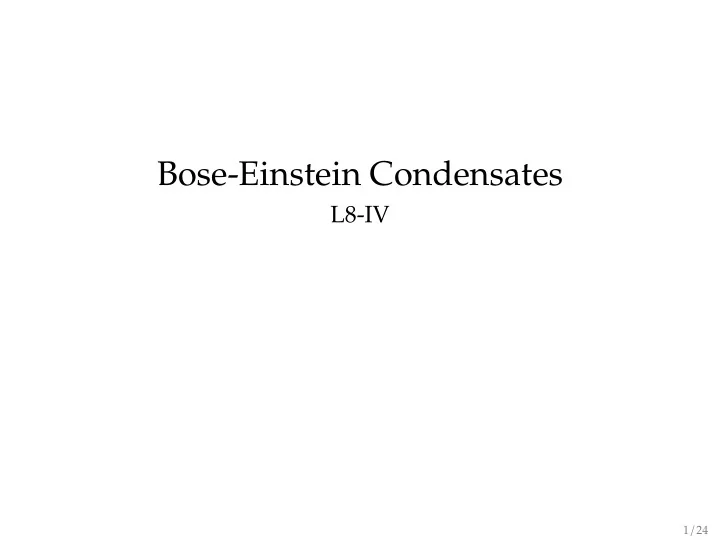

Bose-Einstein Condensates L8-IV 1 / 24
Satyendra Nath Bose • Indian physicist • 1 January 1894–4 February 1974 http: // en.wikipedia.org / wiki / Satyendra_Nath_Bose 2 / 24
What is a Bose-Einstein Condensate? A Bose-Einstein Condensate (BEC) is a state in which all (or most) of the atoms are in the same quantum state. 3 / 24
Review of Quantum Statistics Bosons Fermions s = 0, 1, 2. . . s = 1 / 2, 3 / 2, 5 / 2 . . . examples: photons, examples: electrons, pro- α -particles, most atoms in tons, neutrons their ground states Any number of particles Only one particle can be in can be in the same state a given state A particle in a state in- A particle in a state de- creases the probability of creases to zero the prob- finding another particle in ability of finding another that state particle in that state 1 1 f BE = f FD = e ( E − µ ) /kT − 1 e ( E − µ ) /kT + 1 4 / 24
What is a Bose-Einstein Condensate? A Bose-Einstein Condensate (BEC) is a state in which all (or most) of the atoms are in the same quantum state. 1924 – S. N. Bose first explored the statistics of bosons in the context of photons and blackbody radiation. 1924 – aftter seeing Bose’ work, Einstein predicts the existence of a boson-gas condensate. First BEC observed in 1995 by Carl Wieman and Eric Cornell at JILA / University of Colorado. Awarded the 2001 Nobel Prize for their work. 5 / 24
Carl Wieman and Eric Cornell The JILA / University of Colorado team that first observed Bose-Einstein condensation in a gas. From left to right: Carl Wieman, Michael Matthews, Michael Anderson, Jason Ensher, and Eric Cornell. Their discovery was reported in the article, “Observation of Bose-Einstein Condensation in a Dilute Atomic Vapor,” by M. H. Anderson, J. R. Ensher, M. R. Matthews, C. E. Wieman, and E. A. Cornell, Science 269 , 198 (1995). 6 / 24
Conditions for a BEC The Critical Temperature 7 / 24
Superfluid Helium A sort-of liquid BEC Click here 8 / 24
Conditions for a BEC The de Broglie Wavelength We need 1. The de Broglie wavelength should be as large as possible. (Cold) 2. The average inter-atomic spacing should be as small as possible. (Dense) 9 / 24
A Problem. . . A “universal” phase diagram of ordinary matter: 10 / 24
How Can it be Possible to Achieve a BEC? 11 / 24
Metastable States Example: Supercooled water 12 / 24
Just How Cold? To achieve BECs, the temperature must be reduced to just a few millionths of a degree above absolute zero. The first BEC was achieved at T = 200 nK!! How is it possible to achieve such low temperatures? 13 / 24
Laser Cooling and Trapping (“Optical Molasses”) Magneto Optical Traps, or MOTs The lowest temperature that can be achieved in a MOT is ∼ 0.0001 K – still way too hot for a BEC. MOT animation 14 / 24
Evaporative Cooling 15 / 24
Magnetic Dipole in External Magnetic Field F x = ∂B x µ · � s · � ∂x µ x U ( x ) = − � B ∝ � B 16 / 24
Evaporative Cooling An RF frequency magnetic field is applied with a certain frequency ν to induce a spin flip from spin “up” to spin “down”, thereby removing higher-energy atoms from the trap. By lowering the applied RF frequency the gas can be gradually cooled by evaporation. 17 / 24
Evaporative Cooling Evaporative cooling animation 18 / 24
Weiman and Cornell’s Apparatus 19 / 24
Results Expected Spatial Distribution of Atoms 20 / 24
Results Measured Atomic Density as a Function of RF Evaporative Cooling Frequency Density in the center of the atomic cloud. 21 / 24
The Velocity Distribution of the Trapped Atoms Left to right: 400 nK, 200 nK, 50 nK Note that the thermal distribution is round, while the BEC distribution is elliptical. 22 / 24
The Velocity Distribution of the Trapped Atoms Left to right: 400 nK, 200 nK, 50 nK Note that the thermal distribution is round, while the BEC distribution is elliptical. 23 / 24
Acknowledgments The content of this lecture was taken primarily from the transcript of a talk given by Eric Cornell at NIST in 1996 and based heavily on Dr. Montemayor’s lecture on the same topic. There is a link to Cornell’s paper on the website. The animations are from a great website discussing the work of Weiman and Cornell at the University of Colorado. You can find them, and many others, here: http: // www.colorado.edu / physics / 2000 / bec / index.html 24 / 24
Recommend
More recommend